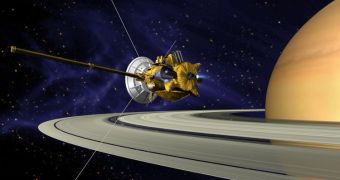A failure in the radio system aboard the Cassini spacecraft orbiting Saturn has its mission controllers at the NASA Jet Propulsion Laboratory (JPL), in Pasadena, California, on the edge. The probe is fairly old, and is now communicating with Earth by using a backup system.
The orbiter has been studying Saturn, its moons and its rings since achieving orbital insertion around the gas giant, on July 1, 2004. Currently on an extended mission, it was never designed to last for so many years. Therefore, it is only natural that some of its components eventually break down.
Something like this happened in late December, when the spacecraft was supposed to contact mission controllers via an ultra-stable oscillator that it also uses to conduct orbital radio imaging experiments.
When that system was unable to activate, a backup component of the communications system automatically kicked into gear, and sent the necessary transmissions. Now, mission controllers are conducting a whole series of diagnostics tests, in order to figure out what happened.
According to the JPL, Cassini is now using an auxiliary oscillator for relaying data to mission control. However, this instrument is not as accurate in conducting radio imaging studies as its predecessor.
As such, the team would much rather prefer to bring the ultra-stable oscillator back online. They say that tests to be conducted by the end of this month will shed more light on this issue, and help them make a decision.
They are also considering age as a potential factor in the malfunction. When push comes to shove, the spacecraft was launch back in 1997, spent 7 years en route through space, and then nearly 8 years around Saturn. Yet, this is the first error to plague the ultra-stable oscillator experiment.
“Some of the data collected for the radio science experiment using the auxiliary oscillator will be of lesser quality than that from the ultra-stable oscillator,” a statement released by the JPL explains.
“Signals used for occultation experiments – where scientists analyze how radio signals are affected as they travel through Saturn's rings or the atmospheres of Saturn and its moons back to Earth – will be of lesser quality,” the document adds.
Even if the main oscillator fails, Cassini will be able to continue communications with Earth using its auxiliary oscillator. Its remaining 11 scientific experiments will ensure that the probe will continue to send back valuable scientific information for at least a couple more years.

 14 DAY TRIAL //
14 DAY TRIAL //